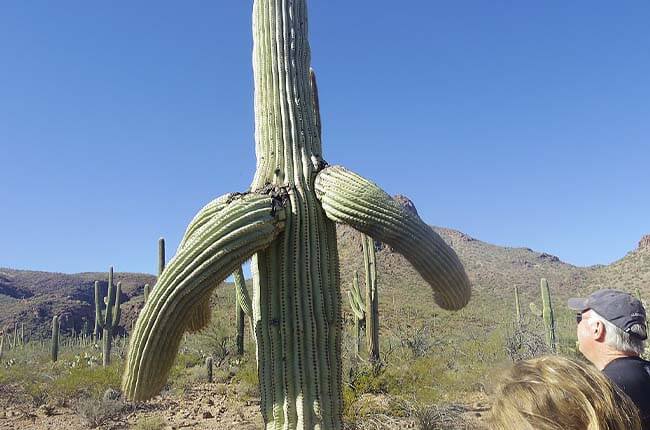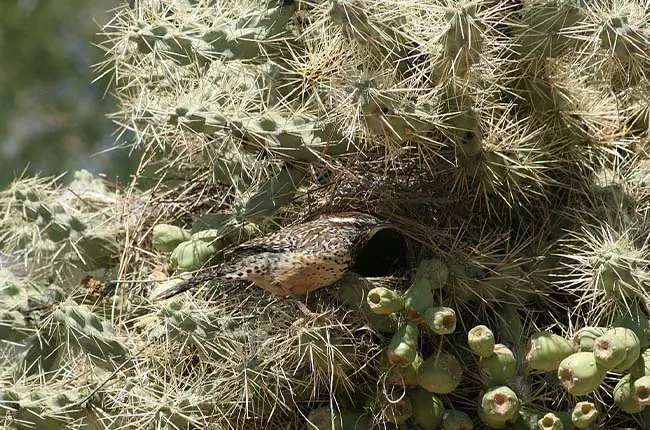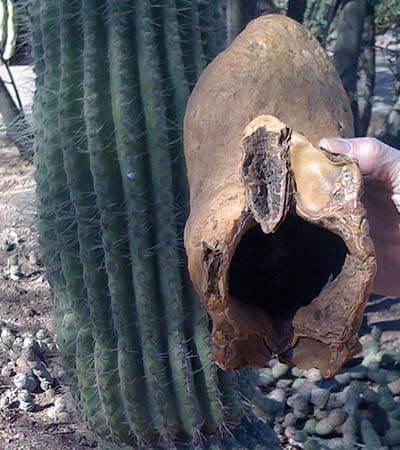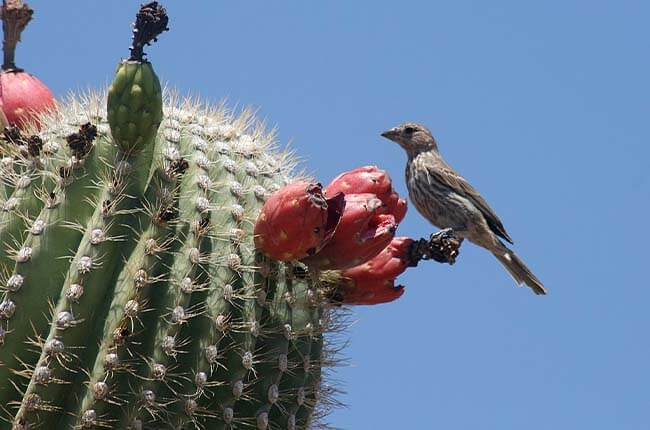Meet the giants of the cactus world—the Saguaro Cacti (Carnegiea gigantea).
In this article, we’re unpacking 28 little-known facts about these iconic plants that showcase their unique characteristics and stories, offering a deeper insight into what makes Saguaros far more than just prickly giants in the desert.
1. Arms growth
A saguaro cactus typically starts growing its first arms once it reaches about 50-70 years of age, but this can vary. Check out this article on how to grow cactus arms.
The arms are grown to increase the plant’s reproductive potential, as more arms mean more flowers and fruits. They also provide extra surface area for photosynthesis, an important adaptation in the harsh desert environment.
But not all saguaros develop arms. The growth of arms is largely dependent on environmental conditions.
2. Arm size
The arms of a saguaro can grow to be quite large. They typically reach a diameter of 2 feet and a length of about 15-18 feet (4.5 – 5.5 meters), but some can grow over 25 feet (7.6 meters) long.
A fully hydrated arm could weigh as much as a few hundred pounds (over 100 liters). This is because saguaros are excellent at storing water, which can account for up to 90% of their weight.
3. Drooping arms
Saguaro cactus arms almost always grow upwards, which is an adaptation to maximize the plant’s exposure to the sun.
However, in rare cases, the arms of a saguaro cactus may point down. This phenomenon is called “cactus droop” or “saguaro droop.”
The exact cause isn’t known but it’s speculated to be due to damage, unusual growing conditions, or genetic variations. Despite the unusual shape, drooping saguaros can be as healthy and long-lived as their upright counterparts.

(WClarke, CC BY-SA 3.0, via Wikimedia Commons)
4. Tallest cactus
The tallest saguaro cactus ever recorded was found in Maricopa County, Arizona, and it was approximately 78 feet tall (roughly 24 meters). Unfortunately, this cactus was toppled over by a windstorm in 1986.
Today, many of the tallest saguaros reach heights of up to 40 to 60 feet (12 to 18 meters). These giant saguaros can primarily be found in the Sonoran Desert of Arizona and Mexico.
Generally, saguaros can reach a height of about 15 to 50 feet (approximately 5 to 15 meters) in 125-150 years.
5. Slowest-growing plant
Saguaro cacti are among the slowest-growing plant species.
In their first decade, saguaros may only grow 1 to 1.5 inches (2.5 – 3.8 cm) in height.
Given optimal conditions, they may grow a little faster, reaching about 6 inches (15 cm) in height after 15 years, but this is still considered quite slow in the plant world.
By the time a saguaro cactus reaches 30 years of age, it might be only 2 feet (60 cm) tall. It generally takes about 50-70 years for the cactus to start growing its first arm.
At around 125-150 years, a saguaro cactus can reach its full height of 15 to 50 feet (4.6 – 15 meters).
6. Oldest cacti
Saguaros are among the longest-lived of all cacti, and the oldest recorded saguaro lived to be around 200 years old. However, the exact age of the tallest recorded saguaro is not known.
7. Water Storage
Saguaros are excellent at conserving water. Their trunks have pleats like an accordion that allow them to expand and contract based on the amount of water they store.
A saguaro cactus that reaches over 32 feet (10 meters) can weigh more than 2 tons (2000 kg) when full of water.
8. Night Photosynthesis
Saguaros, like many desert plants, perform an interesting variation of photosynthesis at night instead of during daytime, called CAM (Crassulacean Acid Metabolism) photosynthesis.
They store carbon dioxide they take in at night to use during the day, which helps minimize water loss during the heat of the day.
9. Blooming at night
Saguaros are one of the few night-blooming cacti.
Each Saguaro flower only stays open for less than 24 hours. It blooms after sunset, remains open during the cooler hours of the morning, and then closes during the hot afternoon.
This adaptation is thought to be a response to the desert heat, as the cooler nighttime temperatures help conserve water in the flower, preventing it from drying out too quickly.
Night blooming also allows the saguaro to be pollinated by nocturnal creatures, such as bats and moths. The lesser long-nosed bat is one of the primary pollinators of the saguaro cactus.
Just like the flowers of most night-blooming cacti, Saguaro cacti produce flowers that are fragrant and white in color, making them easier to spot in the dark.
The flowering season of Saguaro cacti is in the late spring, usually in May.

(Velvetlady0, CC BY-SA 4.0, via Wikimedia)
10. Flowering age
Saguaro cacti do not start to flower until they are at least 35 years old in the lower desert or a hotter and drier region of a desert, or as old as 55-75 years in the upper desert or the cooler areas of the desert at higher elevations.
11. Flower’s official status
The saguaro’s flower is the state wildflower of Arizona.
12. Rarity of mutations
Some saguaros exhibit rare fan-shaped crested mutations, often called “Crested Saguaros.” The cause of this mutation is unknown, but it’s estimated that it occurs in fewer than 1 in 200,000 saguaros.

(James G. Howes, Attribution, via Wikimedia Commons)
13. Cultural Importance
To the Tohono O’odham Nation, a Native American tribe in the Sonoran Desert, the saguaro cactus is considered a sacred plant. The tribe traditionally harvests the saguaro fruit during a ceremony to mark the beginning of their summer growing season.
14. Protected Status
In Arizona, it’s illegal to harm a saguaro cactus. These plants are so important to the desert ecosystem and their growth is so slow, that damaging a saguaro is considered a serious crime, with fines and sometimes even imprisonment as penalties.
15. Shallow roots
Despite their massive size, saguaros have a relatively shallow root system. Most of the roots are within 4-6 inches (10 – 15 cm) of the soil surface, spread out in a radial pattern to efficiently absorb rainfall before it evaporates.
However, there is also a single deep taproot that can extend down to 2 feet (60 cm).
16. Wind Resilience
Despite their height and relatively shallow root system, saguaros are incredibly resistant to high winds. They rarely topple over unless they are water-logged or diseased.
17. Temperature Tolerance
Saguaros are extremely heat-tolerant and are well adapted to the desert environment. They can survive in temperatures over 100 degrees Fahrenheit (38 degrees Celsius), and they can even withstand freezing temperatures for short periods.
18. Not found in all deserts
Saguaro cacti are only found in the Sonoran Desert, which spans across parts of Arizona and California in the United States and extends into the Mexican states of Sonora and Baja California, and in a very small area of southeastern California.
The reason why the saguaro cactus is limited to these areas has to do with the unique temperature, rainfall and soil type it needs to survive and thrive.
19. Homes for wildlife
Saguaros provide homes for many desert creatures. Birds such as Gila woodpeckers and purple martins make holes in the saguaro’s trunk. When the birds move on, these cavities are often used by other species, like elf owls and even bees.
The Cactus Wren, the state bird of Arizona, often builds nests in saguaro cacti. The Saguaro cactus is also a popular home for the Gila woodpecker, purple martin, the house finch, and elf owl.

(BigWheel55, CC BY-SA 3.0, via Wikimedia Commons)
20. Cactus boot
When birds carve out nests in a saguaro and then abandon them, the cactus will form a callus over the hole. This hardened scar tissue is known as a “cactus boot”, and can be found on the ground long after a saguaro has died and decayed.

(Sharktapus aka Sharktopus, CC BY-SA 3.0 US, via Wikimedia Commons)
21. Fruits
Saguaro fruits are red and pulpy, and splits open when ripe, revealing thousands of tiny black seeds.
The fruit is edible and was a significant food source for the Tohono O’odham people, who made it into syrups, wines, and jams.

(Quinn Dombrowski, CC BY-SA 2.0, via Wikimedia Commons)
22. Fruit Harvesting
The Tohono O’odham people use long poles, traditionally made from the ribs of dead saguaro, to harvest the cactus’s fruit.
23. Hard to propagate
Growing a saguaro from seed is a long process and success rates are very low even though a single saguaro fruit can contain up to 2000 seeds. Even under ideal conditions, saguaro seeds have a germination rate of under 1 percent.
The difficulty is due to the tiny size of the seeds which is about 1/10 of an inch (2.5 mm) in diameter and the numerous challenges in the desert, including drought, predation by insects and other animals, and competition with other plants.
Saguaro seeds need specific conditions to germinate and grow. They require a period of warm temperatures and plenty of water, conditions that are rare in the desert. Even when these conditions are met, germination rates are often low.
Even if the seeds do germinate, the young seedlings are extremely vulnerable. They need to be in a location that provides shade and protection, often under a “nurse plant,” to survive the intense desert sun and other environmental hazards.
24. Saguaro Skeleton
When a saguaro dies, it leaves behind a woody skeleton, which consists of a number of woody ribs that run the length of the cactus. This skeleton can remain standing long after the rest of the cactus has decayed.
25. Spines
Saguaro cacti have sharp spines that help to deter animals from eating them. Each spine is sharp and tough, and new ones grow each year from the cactus’s areoles. The spines also provide some shade to the cactus, helping it to conserve water.
26. Unique spine growth
Each areole on a saguaro initially produces about 16 spines. As the saguaro ages, each areole will produce fewer spines until they produce none at all in the later stages of life.
27. Protection from lightning
Saguaros are prone to lightning strikes because of their height, but they have a unique mechanism to protect themselves.
The water inside a saguaro is an excellent conductor, allowing the electrical charge to travel straight to the ground without harming the vital tissues of the cactus.
28. Fire Resistance
Saguaro cacti are surprisingly resistant to wildfires because of their high water content. However, intense fires can still damage or kill these cacti.
In conclusion, the Saguaro Cacti are remarkable symbols of desert resilience, their towering presence tells a fascinating story of survival against harsh conditions. They truly are the undisputed giants of the cactus world.
Related
Do All Cactus Grow Arms: 3 Factors (Explained)
13 Stunning Cacti by Flower Color
5 Ways To Determine The Age Of Cactus
- Keiki Paste vs Rooting Hormone:What’s the difference? - February 4, 2024
- Top 10 Orchid Fertilizers: A Comprehensive Review (2024) - February 2, 2024
- Top 8 Soil Inoculants For Stronger Plants (2024) - February 1, 2024
